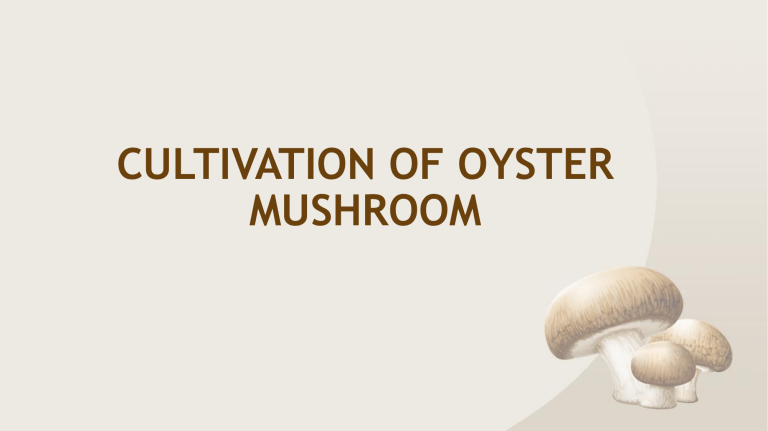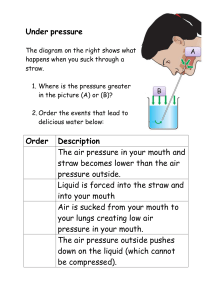
CULTIVATION OF OYSTER MUSHROOM Oyster mushroom is more suitable for our country as: • It can be grown on wide range of agricultural, horticultural and forest wastes. • There is no need of compositing, its cultivation technique is easy and it can be grown on small scale in huts. • It can be grown in tropical part of our country as there are number of varieties that can grow between 20-30°C. Moreover, there are also varieties that can grow below 20 °C. These species also vary in colour. • It has a short life cycle and mushrooms can be easily sun-dried. • It is a nutritious mushroom with medicinal benefits (like presence of cholesterol lowering compound -lovastatin). Some oyster mushroom species varying in colour and temperature requirement P. osteratus 15-18 °C P. sajor-caju 22-30°C P. citrinopileatus 24-28°C P.djamor 24-32°C P. eous 22-28°C Raw materials • Oyster mushroom can be cultivated on wide variety of substrates like wheat straw, paddy straw, maize straw/cobs, cotton hulls, saw dust and so on. • In fact it can be grown on any cellulosic waste. • In India we normally grow it on wheat straw followed by paddy straw. Use of straw as such without any treatment • Soak the straw in water as such overnight and used for cultivation. • To make the pH slightly basic, add lime powder (1%) in the water. • Soak the straw overnight, take it out and air dry before spawning. It must be ensured that the straw is fresh, that is, not exposed to rain. • The spawning rate is kept more, i.e. 4%. Normally, add about 2.5% spawn on wet weight basis. • It may be proper to keep moisture slightly less and also close the bags for higher carbon dioxide production. • This is not recommended method, particularly at commercial level. Cultivation of Oyster mushroom in simple huts in Odisha Pasteurisation using chemicals • We may sterilize the straw using chemicals by soaking it in water containing formalin and carbendazim. • For 10 kg straw about 100 litres of water is needed to which 7.5 g carbendazim (50WP) and 125 ml formalin is added. • Soak the straw in this solution for 18 hours and then take out and air dry for 2-4 hours depending upon the season. Chemical sterilization of wheat straw using bavistin and formalin Hot water treatment after wetting the straw • Wet the straw overnight. • After taking out, soak it in hot boiling water. The straw is allowed to stay in this water for few hours and is cooled before spawning. • The temperature of the hot water may be between 60-65 °C. • Over-boiling does not mean better treatment of the straw. Rather it will lead to partial sterilization of the straw which will attract more diseases. • Soaking in hot water for prolonged period can lead to anaerobic conditions which are not required. • However, it may be difficult to heat large amount of water using wood, oil or electricity. An alternative method is use of solar energy. Direct hot water treatment & use of Solar water heater •Dry paddy and wheat straw can be directly soaked in hot water. •It is important that a temperature of about 60 ±2°C is maintained for about an hour and after that the straw can be spin dried and spawned. •Direct treatment with hot water leads to immediate removal of waxy layer of straw and water absorption becomes easy. •It has been observed that temperature above 65°C can be obtained in solar water heater. • It may be possible to use electricity or integrate electricity and solar systems. • Spin drying machine can be used to immediately remove excess water. •A system using many solar water heaters and drums can be developed and substrate can be filled in the drums at a regular interval of say 15 minutes. This way the spinning machine can be continuously used. Solar energy based model for cultivation of oyster mushroom Pasteurization in the tunnels • Even though pasteurization using hot water is a better method as the heat penetration is quick and uniform, but for commercial scale cultivation of oyster mushroom, it may not be possible to use this method. • Here pasteurization in tunnel will be required. • The method involves wetting straw, mixing 1% lime on dry weight basis, turning the pile of 4’ width, 3-4’ height (length of pile will depend upon the amount of substrate) every alternate day twice, filling in tunnel up to 4-5’, raising the temperature to 60-62°C using steam and maintaining it for 4-6 hours, followed by conditioning for 30-36 hours at 44-48 °C and cooling down. The material is then cooled and spawned. Autoclaving • We may sterilize the straw by autoclaving. • Straw is soaked, excess water is drained and after air drying, it is filled in polypropylene bags and sterilized just like spawn bags. • For cultivation of some species of oyster mushroom like P. eryngii (King Oyster), autoclaving is must. • After autoclaving, the bags are cooled and spawned under sterile conditions before laminar flow. • This approach will ensure better results and very less contamination. • It will be more useful where aim is to produce and sell spawn run bags at commercial scale or develop Ready To Fruit (RTF) packets for urban horticulture. Cultivation of Oyster • Spawn the pasteurized straw @ 2-3% spawn on wet weight basis. • Two-five kg wet substrate can be filled in each bag. In other words, one kg dry straw will require about 100 g of spawn. • Spawn can be mixed thoroughly or put in layers inside the bag. Bags are kept inside room or any hut and can be kept on ground or in tiers as in button mushroom or can be hung from the roof or rack with the help of nylon rope. Bags hung from the racks • Small perforations are made in the bags. • Bags are kept at temperature 24±2 °C. • Spawn run takes about two weeks when whole bag becomes white. No light or fresh air is required for spawn run. Rather it is better to keep the rooms closed. • For induction of fruiting, the bags require diffused light and fresh air for 3-4 hours daily for production of normal fruit bodies. • Large holes can be made in the bag or whole of polythene can be removed. • In 3-4 flushes, one kg of dry straw can yield 0.5 to 1.0 kg fresh mushrooms. The temperature during cropping is kept around below 20°C or around 25°C (depending upon the species) and humidity is maintained above 85%. Temperature requirement will vary with the species. • The development of colour will vary with temperature and duration of fruit-body on the bag. (L to R): Spawning, bag filling, spawn run and fruiting in oyster mushroom Ready To Fruit (RTF) bags • For growing mushrooms for your own self, particularly in urban areas, ready to fruit bags are now available. • The fully colonized substrate is already packed inside these bags and all is needed to do is cut open the box on one or both sides and start watering. • Within 10 days or so you will be able to get the first crop. • RTF bags promote peri-urban horticulture. Ready to Fruit bags Harvesting and Post-harvest storage • Harvest the mushrooms by twisting and cut any straw of substrate that may be there on the stalk. • Do not water the bags before harvesting. • Sun dry oyster mushroom in open or in cabinets. • The drying temperature should not be high (>60°C) as mushrooms dried at higher temperature do not rehydrate properly and also have poor smell. • You can powder the dried mushrooms and powder can be added to biscuits, various other bakery products, health foods, etc. • You can also make pickle of oyster mushroom after blanching just like button mushroom. • As this mushroom produces lot of spores, workers should invariably wear masks inside the cropping room. A few people may be allergic to mushroom spores. • The cultivation method of this mushroom is the easiest. • Cost of cultivation is around Rs. 20-30 per kg under natural conditions.


